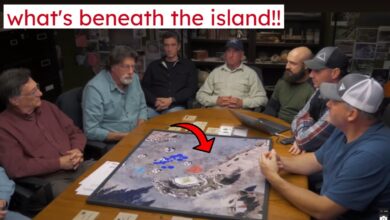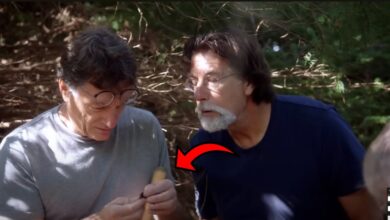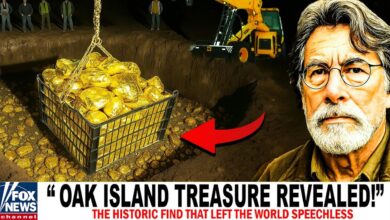The Curse of Oak Island: SHIPWRECK UNCOVERED During Deep Sea Dive (Season 9)
The Curse of Oak Island: SHIPWRECK UNCOVERED During Deep Sea Dive (Season 9)

Dr. Lee Spence Tony, thank you for coming.
What we’re about to undertake is important.
Rick Lagina, along with his nephew Alex and members of the team, have gathered in the war room to plan a highly anticipated dive operation with Tony Sampson and renowned underwater archaeologist Dr. Lee Spence.
We do have some data provided by CSR Geoservice. Dr. Spence, you have had an opportunity to look at some of that data.
Very interesting.
With more than 50 years of experience as a treasure hunter and underwater explorer, Dr. Spence has located more than 100 shipwrecks and discovered more than 50 million dollars in artifacts and treasure dating back to as early as the 15th century.
What we ask of Dr. Spence is to look at that CSR data, that mag data, and see if you can suggest to us what these targets might be and whether or not you saw anything worth Tony diving on.
So, Steve, if you could bring that data up…
Sure.
So, there are the anomalies supplied to us from CSR. The reason for the dive obviously is to try to explain those two mystery targets up there.
Yep, exactly. And that’s the Frog Island Shoal one. As you can see, there’s a number of targets around the island, but those are probably the two most interesting. They should be.
We’re heading towards the Frog Island Shoal, mate. One week ago, Rick, Marty, and Craig commissioned representatives from CSR Geo Surveys Limited to conduct a magnetometer survey across the northern waters surrounding Oak Island.
Oh, is that ahead?
That’s a hit!
Yeah, incredibly, the scans identified a number of compelling anomalies, including one adjacent to Lot 5 and also a massive object near Frog Island to the east of Oak Island, one that could potentially be the wreck of a large sailing vessel.
This area up here—if I’d done this mag and I saw these targets, I would think, okay, looks like we have one or two shipwrecks right here. That’s great.
Well, it’s exciting! Here’s a man who really knows what he’s talking about. Dr. Spence thinks that the anomaly near Frog Island is indeed a shipwreck.
For our purposes, it could be a shipwreck that helps us solve our mystery.
Here, this looks like a shipwreck to me.
That’s the one off of Lot 5.
Yes, now, this is very shallow water. You can have shipwrecks in extremely shallow water, but you have all of this geology here, and so there are lots of things that it could be.
Although Nova Scotia law restricts treasure hunting in open waters, it is the team’s hope that if they can find evidence of a wreck, they can acquire a special permit to investigate it more thoroughly.
So, what’s your approach then, looking at the Frog Island Shoal one?
I would take their handheld mag out, and if you’ve got a six-foot linear feature down there, you know, then the heart starts to beat a little bit because it might be a cannon or an anchor or something.
Well, I think all that can be said at this point is, you know, go find a shipwreck.
Okay, yes, we will indeed.
So, we’re about on the spot now, guys. Alex Lagina and his cousin David Fernetti joined diver Tony Sampson and his team along with underwater archaeologist Dr. Lee Spence to investigate the waters between Oak Island and neighboring Frog Island.
What do we got for depth, Ryan?
19 feet.
19 feet, sweet. Great. Okay, let’s get up and, um, we’ll go and splash this one.
We’re gonna drop the anchor, Jamie.
Tony and Dr. Spence will be conducting a dive in an effort to collect more data regarding the metallic anomalies that were detected during the recent magnetometry survey. The target today is a cluster of magnetometer hits that could be a shipwreck on Frog Island Shoal.
However, due to environmental restrictions, they will only be able to perform a non-invasive investigation of the ocean floor using cameras and handheld scanning devices.
Away we go.
If evidence of man-made objects or human activity is found, the team can apply for a permit to dig out as well as remove objects from the area.
Hopefully, they get a hit soon because the ocean floor is covered with vegetation.
Tony Sampson is utilizing an AquaScan DX200 handheld magnetometer, which emits magnetic pulses capable of detecting iron targets buried up to 23 feet below the ocean floor.
Five minutes.
Surface to diver, we hear you, over.
At a depth of some 20 feet in the waters between Oak Island and nearby Frog Island, diver Tony Sampson and underwater archaeologist Dr. Lee Spence have just confirmed that some kind of a large metallic object is buried beneath the thick vegetation on the ocean floor.
Copy you, Tony, that’s great news. Do you see anything sticking out from the bottom? Anything prominent over?
Copy.
Fingers crossed they see something. Really, we need permission to move the silt and see what they’re actually finding.
To get a permit, we need to lay eyes on something underwater that comes from a shipwreck. A magnetometer hit is not going to be enough.
We need Tony or Lee to see something—a cannon, a coin, timbers from a ship, something on the bottom.
Because the silt and vegetation is preventing Tony and Dr. Spence from seeing the metal object or objects they have just detected, they are now expanding their search area in order to look for any visible debris that could help determine just what they have found.
Thank you.
We hear you, go ahead, over.
[Music]
Another magnetometer hit.
Is it possible that Tony and Dr. Spence have found more evidence of human activity and possibly the remains of a shipwreck?
If so, could it be connected to the recent ship-related discoveries that the team has made in The Money Pit?
Copy that, nothing visible over.
All right, copy that.
Gets in the silt, nothing on the rocks.
Copy you, we’ll see you on the boat soon, over.
Well, there were actually two areas out on that shoal where we did find a reading that was buried, uh, that could be part of a ship.
But so much of the bottom there were large rocks and a lot of kelp growing, and it could have easily hidden a wreckage that sailed.
Very interesting, Diet. Yep, I’m absolutely convinced that there’s a ship right there.
Hey, hey, hi, guys! How you doing? How’d it look?
Well, you know, there was a reef line there, we could see it. There was structure.
Good, but everything solid had kelp on it, and so that kelp could have been hiding part of a shipwreck, like a fluke of an anchor sticking up.
Right, so you think maybe further investigation?
Oh, I definitely think that. No question about it.
And I would not write off.
Right, okay, well, that’s good. I mean, I would love it, but whatever we’re getting is below the silt.
Yeah, they’re never going to issue us a permit because it’s going to be buried, and we can’t see it.
Right, right.
All of the evidence—and even the expert—is saying there’s a shipwreck here, but none of it is enough to get an excavation permit.
Our only hope really would be to come back and hope that just the natural action of the tide and maybe some storms uncover some evidence of a shipwreck, at which point we could get an image of it and then apply for an excavation permit.
It’s great, and this is our most promising spot. And if you go down there and you think that it warrants further investigation, I think that’s good.
Should we continue with the shipwreck investigation?
100%.
So, a continued dive program is warranted late winter, early spring because that’s when the water clarity is best.
Well, I think, yeah, we’ll probably have to keep Lee here for another year, I think.
Okay, let’s pull anchor and get out of here, guys.








